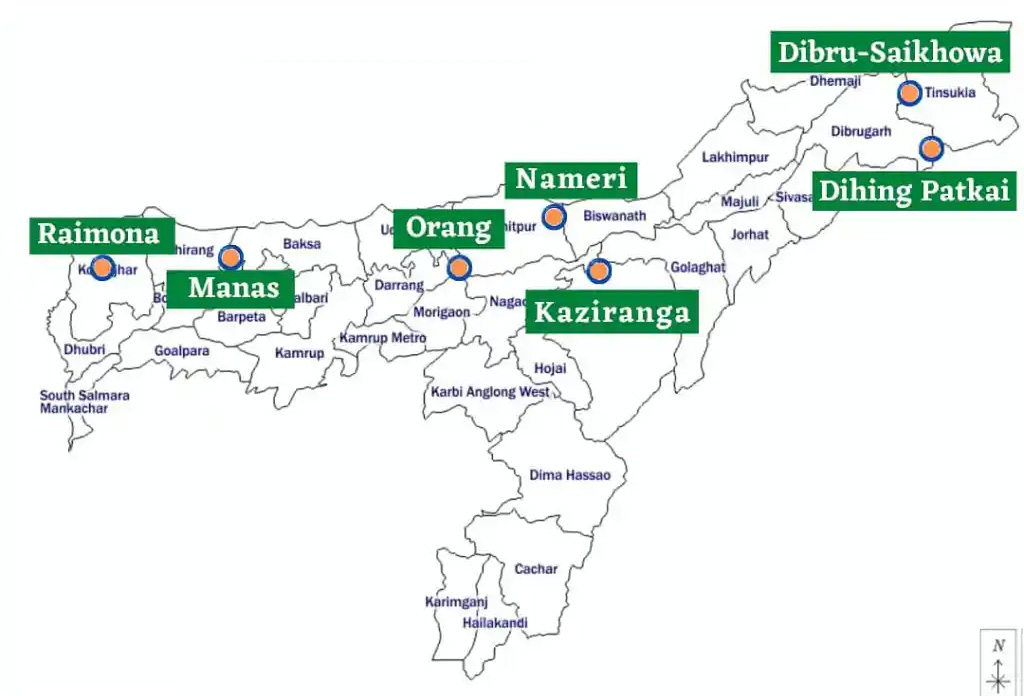Important Facts For Prelims
Rowmari-Donduwa Wetland Complex
- 04 Nov 2025
- 6 min read
Why in News?
There is a demand for the inclusion of the Rowmari–Donduwa Wetland Complex in Assam as a Ramsar Site, recognizing its remarkable biodiversity and ecological significance.
What is the Rowmari–Donduwa Wetland Complex?
- Location: It is located within the Laokhowa Wildlife Sanctuary (WLS), a part of the Kaziranga Tiger Reserve in Assam. It is an interconnected floodplain–marsh system spanning about 2.5 to 3 square kilometres.
- Biodiversity: It hosts a higher diversity of bird species compared to the two existing Ramsar sites in Northeast India — Deepor Beel (Assam) and Loktak Lake (Manipur).
- The 2025 Kaziranga Wetland Bird Census recorded 47,000+ birds from 75–88 species, including Knob-billed Duck, Black-necked Stork, and Ferruginous Pochard.
- Ramsar Site Designation: The Rowmari–Donduwa Wetland Complex, with its rich birdlife, diverse habitats, and strong ecological links, is an ideal candidate for Ramsar Site designation.
What is Ramsar Convention?
- About: The Ramsar Convention, signed in 1971 at Ramsar, Iran, is an international treaty for the conservation and wise use of wetlands. It aims to protect wetland ecosystems through national and global cooperation.
- India and Ramsar: India, a member since 1982, has 94 Ramsar sites (as of November 2025), the highest in Asia, supporting biodiversity and livelihoods.
- The first Ramsar Site designated in India was Chilika Lake, Odisha, in 1981.
- Currently, Tamil Nadu leads with the highest number of Ramsar Sites, followed by Uttar Pradesh.
- Approximately 10% of India’s total wetland area is currently designated under the Ramsar framework.
- Criteria for Ramsar Site Designation: There are 9 criteria for identifying Wetlands of International Importance under the Ramsar Convention. Important ones are:
- Ecological Uniqueness & Biodiversity: Represents a rare wetland type and supports key or endangered species.
- Life Cycle Support & Refuge: Provides habitat during critical stages or refuge in adverse conditions.
- Avian Importance: Hosts 20,000+ waterbirds or 1% of a waterbird population.
- Aquatic Significance: Sustains diverse fish species, serving as a spawning, nursery, or migration ground.
Laokhowa and Burhachapori WLS
- Location: Situated between Kaziranga (east), Orang (west), and Pobitora (west), the complex forms a vital migration corridor between Kaziranga and Orang National Parks.
- It serves as a Buffer Zone of Kaziranga Tiger Reserve, with the Brahmaputra River marking its northern boundary and creating diverse river islands (chars).
- Biodiversity: Home to endangered mammals like the Great Indian One-horned Rhinoceros, Royal Bengal Tiger, Asiatic Elephant, and Asiatic Water Buffalo, along with otters and pangolins.
- Rich in birdlife, including Bengal Florican, Greater and Lesser Adjutant, and Black-necked Stork; the Brahmaputra River supports the Gangetic River Dolphin.
- Ecosystem: Features a diverse mix of grasslands, woodlands, wetlands, and riverine islands.
Kaziranga National Park
- About: Established in 1908, the park is located in Assam’s Golaghat and Nagaon districts. It was declared a National Park in 1974, inscribed as a UNESCO World Heritage Site in 1985, and designated a Tiger Reserve in 2006.
- Fauna: Home to over 2,200 Indian One-horned Rhinos—about two-thirds of the global population—the park also sustains tigers, elephants, wild water buffalo, and bears.
- It supports rich aquatic life, including the endangered Ganges River Dolphin, and serves as a vital refuge for resident and migratory birds.
Frequently Asked Questions (FAQs)
1. What is the Rowmari–Donduwa Wetland Complex?
The Rowmari–Donduwa Complex is a 2.5–3 km² floodplain–marsh within Laokhowa WLS, part of the Kaziranga landscape; it supports 120+ bird species and high avian counts, making it ecologically significant and a strong candidate for Ramsar designation.
2. How does Laokhowa–Burhachapori contribute to wildlife conservation in Assam?
Laokhowa–Burhachapori functions as a buffer and corridor connecting Kaziranga with adjacent PAs, supporting large mammals (rhino, elephant, tiger), wetlands for migratory birds, and riverine species like the Gangetic dolphin.
3. What distinguishes Kaziranga National Park's global conservation status?
It is a UNESCO World Heritage Site and Tiger Reserve, holding the world's largest population of the endangered Indian one-horned rhinoceros.
UPSC Civil Services Examination, Previous Year Questions (PYQs)
Prelims
Q. Consider the following pairs: (2013)
| National Park | River flowing through Park |
| 1. Corbett National Park | Ganga |
| 2. Kaziranga National Park | Manas |
| 3. Silent Valley National Park | Kaveri |
Which of the above pairs is/are correctly matched?
(a) 1 and 2
(b) 3 only
(c) 1 and 3
(d) None
Ans: (d)
Q. Among the following Tiger Reserves, which one has the largest area under “Critical Tiger Habitat”? (2020)
(a) Corbett
(b) Ranthambore
(c) Nagarjunasagar-Srisailam
(d) Sundarbans
Ans: (c)







